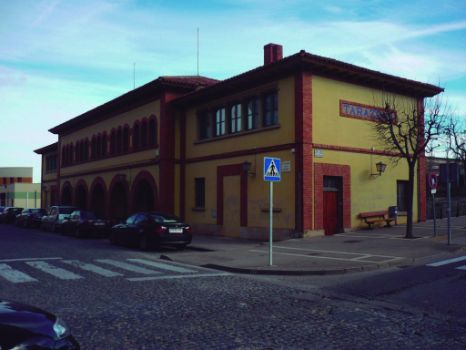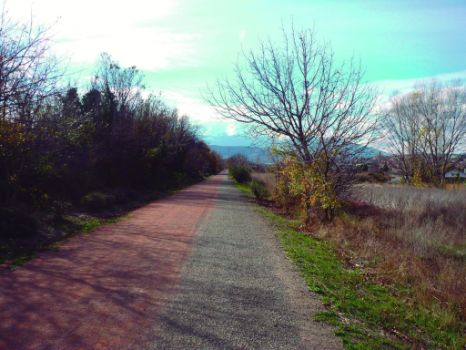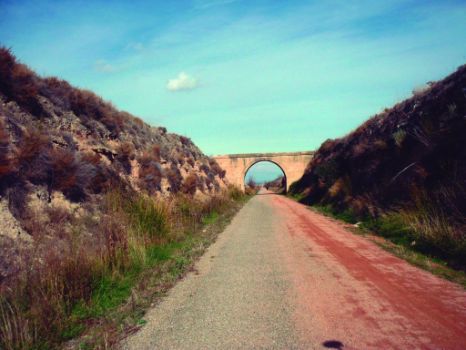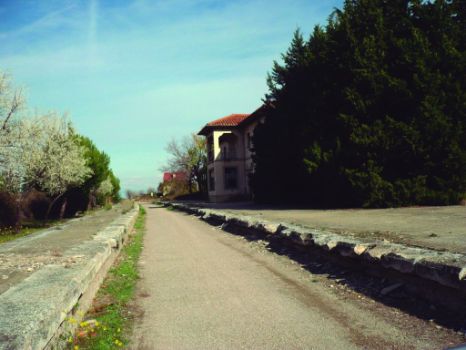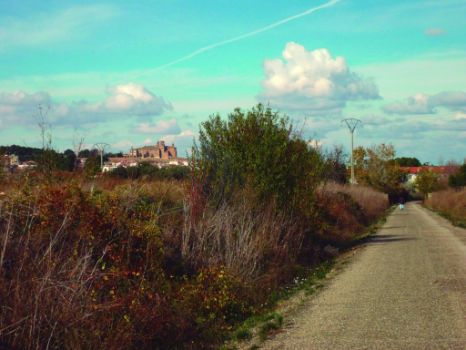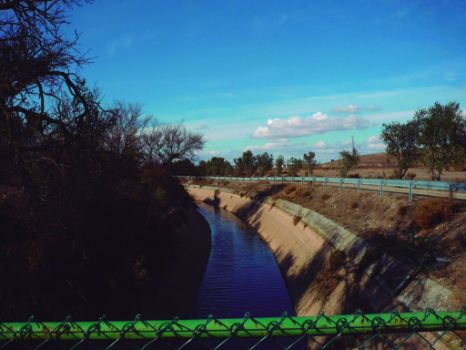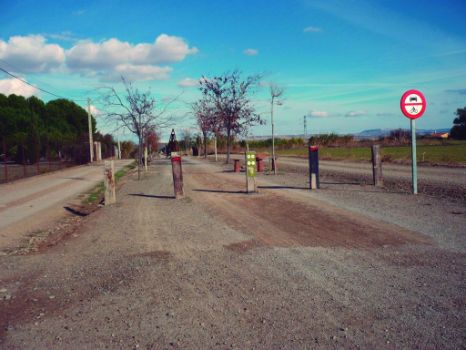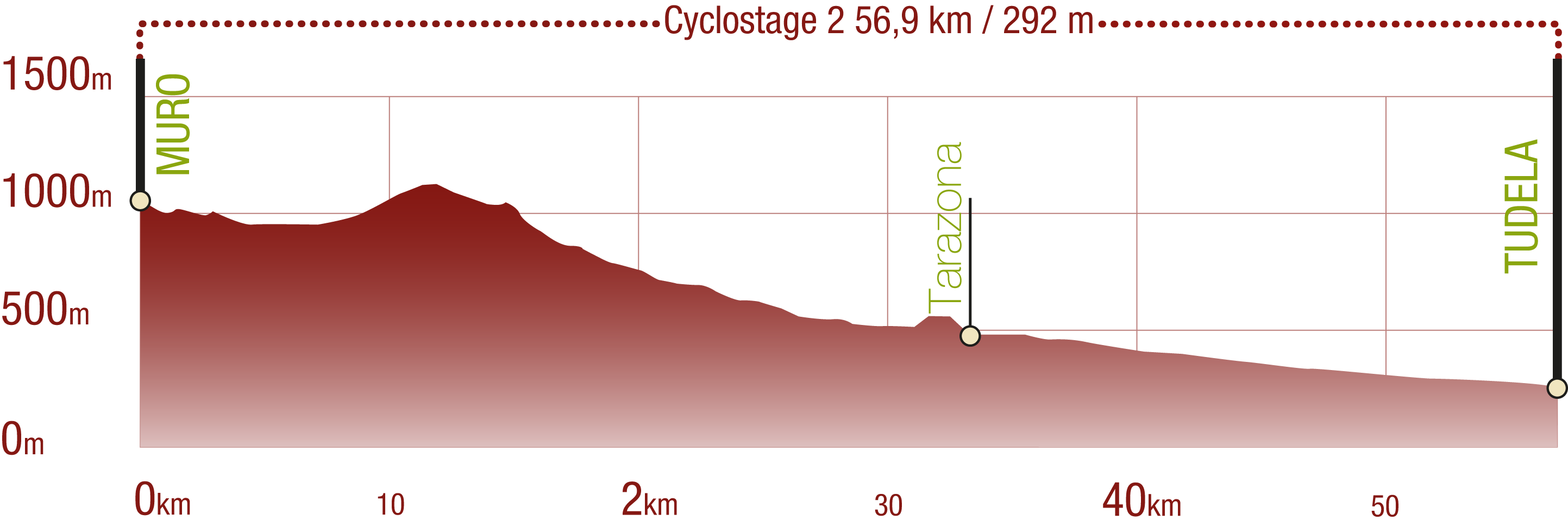Net of Natural
Trails

Stage 6: Tarazona - Tudela
Description
Tarazonica Greenway Nature Trail
The sixth and final section of the Agua Soriano Nature Trail, 22 km in length, links Tarazona with Tudela in Navarre. It runs along the Tarazonica Greenway Nature Trail, an old railway line, now converted into an interesting cyclo-tourism route, with stations at Tulebras and Cascante.
The sixth stage of the Route traverses irrigated croplands, canals and irrigation ditches. The old train stations along its path have been converted into rest areas. In this lower section of the River Queiles Valley, the route crosses the Lodosa canal and passes next to the Cistercian monastery of Tulebras to finally reach Tudela, where the Agua Soriano-Camino Antonino Nature Trail ends after an exciting journey of 116 km through the lands of Soria, Aragón and Navarre.

At the edge of Tarazona
The route begins in the southeast of the city of Tarazona. It first heads down the entire length of Crucifijo Street, leaving behind the urban area, and then continues northeast along Fueros de Aragón Street. Next, it turns onto Bajada a Pradiel Street that leads to the River Queiles. The route follows the river downstream to Plaza de San Francisco, where it turns onto the road to Saragossa. Further on, it crosses Ciudad de Teruel Avenue, past the railway station, to arrive at the trailhead: the Tarazonica Greenway Nature Trail.
The Trail continues northeast along the old Tarazonica railway line, which in this first section passes through vegetable gardens criss-crossed by irrigation ditches and dirt tracks. This railway was operational from 1885-1972. The stops at Murchante, Tulebras and Malón served as a gateway to several nearby towns that did not have a station, like Ablitas, Barillas, Monteagudo and Vierlas. All six former train stations, scattered along this route, have been converted into rest areas. This railway line was popularly known in the area as “El Escachamatas”.
After traveling just over three kilometres, the route passes near Vierlas, located just over a kilometre to the east of the Nature Trail. From here, the trail approaches the river bed, along its right bank. Further on, almost in the boundary between Aragón and Navarre, the route winds between Novallas and Malón, located west and east of the path, respectively.
Next to the Malón station platform is a rest area from where the houses of the village can be seen atop the hill. The square of an ancient castle, long disappeared, stands in the highest part of the village, with good views of the river plain.

Tulebras
Further along the Nature Trail, there are several tree stands, the first of which has been furbished as a rest area. From here, the Nature Trail continues towards Tulebras, the first stop-off in the province of Navarre. Tulebras is located next to the River Queiles, in the southern part of the Ribera Navarra, an area with rich vegetation and pleasant landscapes dominated by vineyards and olive trees (Olea europaea).
At the Tulebras railway stop, the traveller can get some reset or visit the Royal Cistercian Monastery of Santa María de la Caridad which, interestingly, is integrated into the old station. No one should leave the monastery without tasting their excellent sweetmeats, in particular, the delicious biscuits. The nuns also make honey, handicrafts and creams.
Although there is some evidence that the site was already inhabited in the Bronze Age, the first documented reference to the town dates from 1125. The first written testimony mentions a mainly agricultural Muslim settlement built over an ancient Roman villa, one of many that existed around Cascantum (Cascante).
Due to its border location, the town was continuously involved in border disputes between the kingdoms of Castile, Navarre and Aragón since the Middle Ages. In the fourteenth century, Tulebras was devastated by the Castilian wars and its inhabitants abandoned the town, leaving only the nuns. The Monastery's lack of means for subsistence, based primarily on farming, compelled the nuns to grant concessions to the neighbours in order to repopulate Tulebras. Nonetheless, the religious order established as an indispensable condition that these neighbours had to work as day labourers for the Monastery. It was not until 1812, with the Cortes of Cadiz, when the town became independent of the religious order and the lands were transferred to the inhabitants, mainly into the hands of the local nobility.
Tulebras is also surrounded by natural spaces of high landscape value, such as Laguna de Lor, Bardenas Reales, Sotos del Ebro or Bocal. There is also a recreation area in the famous Fuente de las Ranas, on the banks of the River Queiles, very close to the station.
Near Tulebras, the route continues along N-121. After about two kilometres, it reaches the town of Cascante, where there is a rest area in the old train station.

Cascante
Cascante is located on a hill at an altitude of 356 m. The lowest and highest points within the municipal boundaries are 300 m at the River Queiles, along Tudela's irrigation ditch, and 660 m up the mountains, on the boundary with Tarazona. The forests, populated only with poplar groves and small reforestation pine woods (Pinus halepensis), are dominated by the Cierzo (northerly wind). Most of the territory is agricultural land, with rainfed cereal crops and vegetable gardens in irrigated areas. There are also olive groves, vineyards and almond trees (Prunus dulcis). Present-day Cascante sits where Roman Cascantum stood, a “mansio” or stop along the Roman road that linked Asturica Augusta (Astorga) and Turiasso (Tarragona). Neolithic-Bronze sites have been found within the municipality. It was also a Celtiberian city until its destruction by Sertorius in 76 B.C. Before Roman times, it was called Kaiskat.
In 465, the city already had a Christian community. The origins of certain words like “regadío” derive from the Arab domination. Cascante passed into Christian hands in 1119 as integral part of Tudela. It already had a castle in the twelfth century.
The church of La Victoria, a former convent of which there are still some remains, is located in the town centre. The temple is of Gothic-Renaissance style, with a single nave divided into two sections and a pentagonal sanctuary. Inside is a 17th century Mannerist altarpiece with a statue of the Virgen de la Victoria and a Christ on the Cross.

The parish church of Asunción, from the sixteenth century, is another religious building in Cascante. It was almost completely destroyed by an accidental fire in 1940. The interior was rebuilt according to its former layout with three naves and a polygonal apse. Of the original church there remains an interesting collection of paintings, including a painting on wood of La Asunción.
The Basilica of Romero, situated in the highest part of the town, has a baroque arcaded brick gallery with 39 arches that connects the temple to the town. One can see the entire Queiles River Valley and numerous towns in Aragón and Navarre from this hill. The church of Nuestra Señora del Romero was built in the late seventeenth century in the same place where another temple, destroyed by fire, once stood. Some of the elements from the temple can be seen in the church. Only the Gothic chapel, which holds the original 16th century altarpiece, remains from the original building. Inside is the statue of the Virgen del Romero.
The Nature Trail continues towards Tudela. The route turns onto N-121 near Murchante, located about 1,300 m from the route, making a sweeping curve between motorways, roads and industrial buildings. The Trail enters Tudela through its south-eastern edge, and ends near the train station.

Tudela
Located on the banks of the Ebro, Tudela is a city with a rich monumental heritage shaped by its long history. Founded by the Arabs in the ninth century, it was the third largest city in the “Marca Superior” of Al-Andalus. Arabs, Jews and Christians co-existed in Tudela. It was a leading cultural hub, with prominent Koranic and rabbinic schools. The Arab inhabitants left their mark in the decorations in stone that still can be seen in the ancient main mosque, the Monreal Tower and the 360-metre bridge over the River Ebro, with 17 arches, a true engineering feat that is the emblem of the city.
The presence of Arabs and Jews since the ninth century has left its footprint also on the layout of its streets. Almost since the foundation of Tudela, the Jews lived near the River Queiles, in the area southeast of the wall, known as Judería Vetula, where three synagogues reportedly existed. However, in 1170, Sancho VI the Wise, King of Navarre, ordered the relocation of the Jewish quarter next to the castle walls. This was called the Judería Nueva.
During the Middle Ages, several religious buildings were constructed in the twelfth century, including the Romanesque church of La Magdalena, built over a Moorish temple, and the Cathedral, built around 1180 over the ruins of an ancient mosque, which has a remarkable cloister.

The 16th century City Hall is located next to the Cathedral. There are also several Plateresque-style mansions and palaces from that same period, including the Dean’s palace, the palace of the Marquis of San Adrián, the Casa del Almirante and the house of Ibánez-Luna. The hospital of Santa María de Gracia is also from the sixteenth century.
From the eighteenth century are the palace of the Marquis of Huarte, with an impressive, imperial staircase, and the mansion of the Earls of Heredia Espinola, both in neoclassical-style. There is also the Plaza de los Fueros, built in 1789 to resemble a bullring. This baroque square serves as a transitional zone between old and modern Tudela. The churches of San Nicólas de Bari and Colegio de la Enseñanza are also from this century.
Also worthy of note is the religious architecture of the convents of Carmen and Dominicas, from the 17th century, and Capuchinos and Clarisas, 18th century.
Crossroads of cultures, Tudela is also a benchmark for routes in natural environments of high ecological value, including the one leading to Bardenas Reales, a 42,500 ha area declared a Nature Park and World Biosphere Reserve.

Copses and alluvial ecosystems still survive in this riparian environment, a land habitat with abundant wildlife. A wide variety of bird species can be found in the copses, including common nightingale (Luscinia megarhynchos), purple heron (Ardea purpurea), Eurasian wryneck (Jynx torquilla), black kite (Milvus migrans), European turtle-dove (Streptopelia turtur), kingfisher (Alcedo atthis) or European bee-eater (Merops apiaster). There are also fishes like the carp (Cyprinus carpio) or barbel (Luciobarbus guiraonis); amphibians and reptiles such as the Iberian frog (Rana perezi), viperine snake (Natrix maura); and mammals, like the shrew (Crocidura russula), vole (Pitymys duodecimcostatus), genet (Genetta genetta), fox (Vulpes vulpes) and wild boar (Sus scrofa).
Another route which leads to Sotos del Ebro runs 30 km along the banks of the river, starting in Santa Barbara Hill, a vantage point over the city of Tudela with views of the River Ebro, its vegetable gardens and groves. This trail leads to Mejana, a small expanse of vegetable gardens that has existed since the Arab period, and continues towards Norias Reservoir and Soto de los Tetones, where rice paddies are extensively cropped. The route continues along the “Pasada Principal del Ebro” drover's trail, through protected copses, including La Remonta, El Aguadero, El Ramalete Alto, El Aislado, Sardavilla, Vergara and Traslapuente.
Finally, it must not be forgotten that the Agua Soriano-Camino Antonino Nature Trail meets the Ebro Nature Trail (GR 99) at Tudela. The Ebro branch of the Way of St. James towards Santiago de Compostela also passes through Tudela.
Managing Entities
- Ministerio de Agricultura, Pesca y Alimentación
Sites of interest
Puntos de interés
Culture
Infrastructure
- Estación de Tarazona
- Estación de Tudela
- Estación de Murchante
- Estación de Cascante
- Estación de Malón
Municipality
Passport
Profile
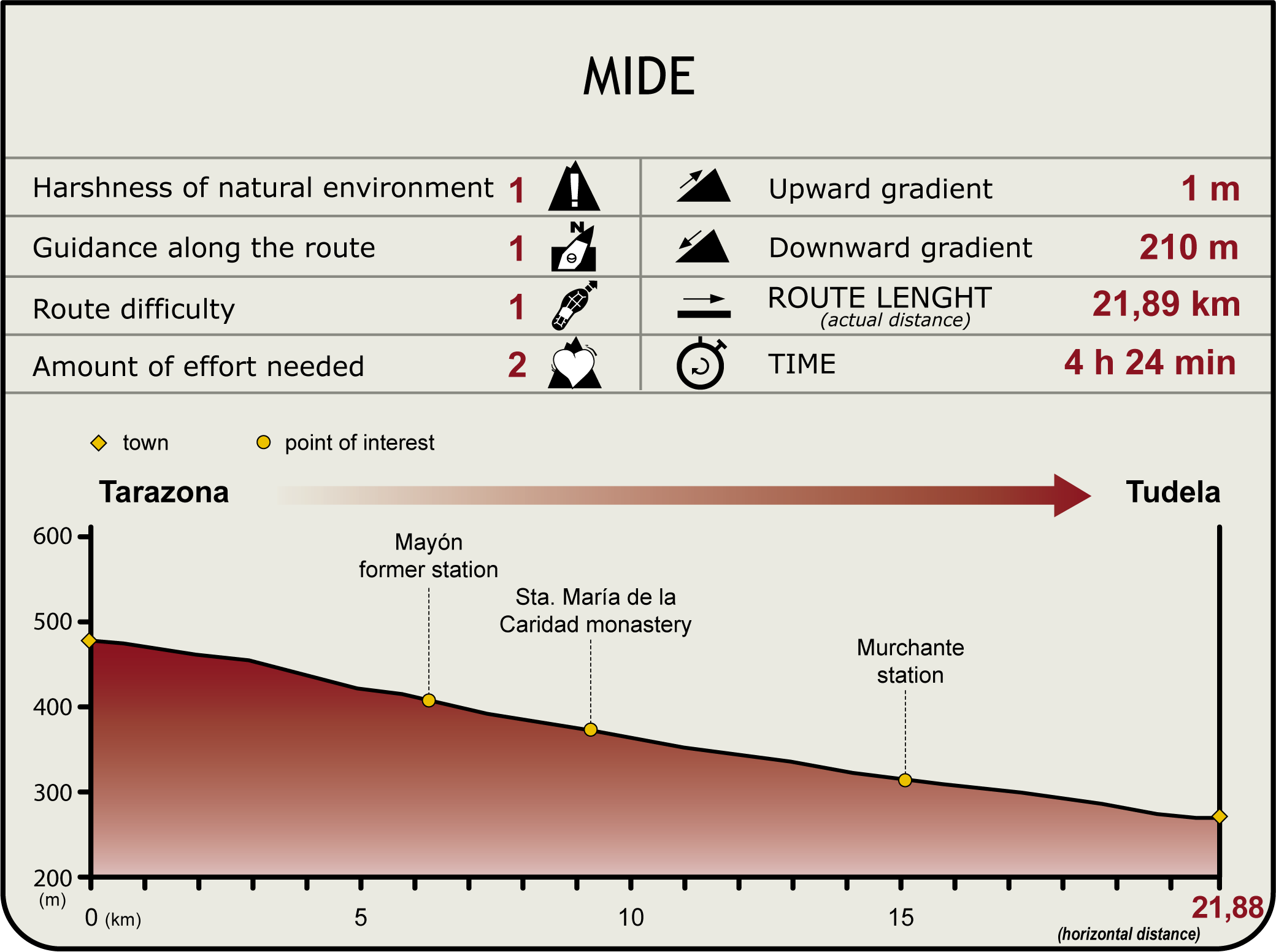
(Calculated according to the MIDE criteria for an average excursionist with a light load)</
Highlights
Further information
"El Escachamatas"
In 1885, the Compañía del Ferrocarril del Norte opened a modest narrow gauge railway line between the cities of Tudela (Navarre) and Tarazona (Saragossa). The "Tarazonica" or "Escachamatas”, as it was popularly referred to by the local inhabitants, was best known for its slowness and inefficiency.
An equally unsuccessful endeavour began in 1953 when Renfe widened the rails. However, trucks and buses won the battle for freight traffic, and the "Tarazonica" was definitely abandoned on December 31, 1972 after years of decline.
Monastery of Santa María de la Caridad
The Royal Cistercian Monastery of Santa María de la Caridad is the oldest female Cistercian monastery in Spain. Although the Cistercian Order settled here in the twelfth century, the Monastery date back to 1147, when King García Ramírez asked the nuns of the monastery of Favars (France) to found a branch of the order in Navarre. They first settled in Tudela, but wanting to find a quieter and more isolated location, they moved to Tulebras in 1156.
Worthy of note in this monastic ensemble is the Romanesque church, with semicircular apse covered by a 16th century star vault, the cloister, from the same period, and the 18th century abbot's palace in baroque-style. In the interior, on the high altar, are a 14th century Gothic image of Nuestra Señora de la Caridad, and an interesting museum with invaluable pieces, including a magnificent Renaissance altarpiece, various works in gold and silver, sculptures and paintings from different periods.
Laguna de Lor
Near the Nature Trail, between Tulebras and Cascante, is Laguna de Lor, a beautiful site for fishing and taking walks. An irrigation pond, fed by the River Queiles, provides an interesting aquatic ecosystem. There is a walking route of about two kilometres that circles the pond and traverses a landscape of centennial olive trees.
Laguna de Lor is one of many ponds or wetlands in Ribera Navarra, with a typical aquatic ecosystem home to different species, some endangered. This lagoon attracts numerous waterfowl, including cormorant (Phalacrocorax sp.), coot (Fulica atra) and Eurasian wigeon (Anas penelope). Autumn and winter are the best time of year for bird-watching in Laguna de Lor.
Ebro Way of Saint James
The Ebro Way of Saint James starts in Tortosa, and climbs to Logroño along the River Ebro, where it joins the road that comes from Roncesvalles. The route runs some 40 km through Navarre, and ends in Rioja, between Castejón and Alfaro. It passes through Gandesa, Caspe, Saragossa, Tudela, Alfaro and Calahorra to arrive at Logroño.
The discovery of the tomb of St. James, in the ninth century, attracted pilgrims from all over the world via different routes. One of which was the Ebro Way of Saint James, used by pilgrims from the Mediterranean basin who travelled along the Ebro to connect with the French route.
The Ebro Way of Saint James through Tudela is signposted with bronze scallop shells that indicate how to get to the cathedral and out of the city towards Castejón. The scallop shells first point the way to the Tudela Municipal Shelter for pilgrims, and from there to the historic old town.
The pilgrimage route to Santiago runs through the medieval web of narrow streets, amidst many monuments of different historical periods, to reach Tudela Cathedral. It then skirts around the temple to Portal Street, which leads directly to the church of La Magdalena, with a nice view of the bridge over the Ebro through which the route leaves Tudela.
Multimedia
Downloads
GPS Downloads
Documents
Cyclability
TYPE OF ROAD, PORTAGES & DIFFICULTY
SAFETY RECOMMENDATIONS
- Sections shared with hikers and agricultural vehicles.
- Transit through the centre of some population centres.
GENERAL RECOMMENDATIONS
- Find out about the technical aspects of the route and the weather on the day.
- Take care of the environment. Take care not to disturb animals or damage vegetation. Respect private areas.
- You must give priority to pedestrians and comply with general traffic rules.
- The environment in which you will be riding is open, free to move around and an area where many activities are carried out (sporting, forestry, livestock and agricultural activities). Always have an understanding, prudent, responsible and respectful attitude.



